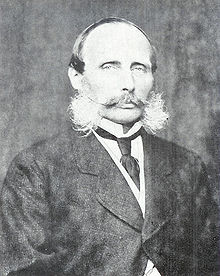Prince Henry of the Netherlands (1820–1879)
You can help expand this article with text translated from the corresponding article in Dutch. (May 2013) Click [show] for important translation instructions.
|
| Prince Henry | |
|---|---|
 | |
| Born | 13 June 1820 Soestdijk Palace, Baarn |
| Died | 14 January 1879 (aged 58) Walferdange Castle, Walferdange |
| Spouse | |
| House | Orange-Nassau |
| Father | William II of the Netherlands |
| Mother | Anna Pavlovna of Russia |
| Religion | Dutch Reformed |
Prince William Frederick Henry of the Netherlands (Dutch: Willem Frederik Hendrik; 13 June 1820 – 14 January 1879) was the third son of King William II of the Netherlands and his wife, Grand Duchess Anna Pavlovna of Russia. He was born at Soestdijk Palace.
Prince Henry became Governor of Luxembourg in 1850, in which capacity he served until his death in 1879. During his tenure, he worked with the government to launch the reactionary Coup of 1856, which consolidated power in the monarchy and the executive.[1] However, most of the changes were reversed by the new constitution issued in 1868 after the 1867 Luxembourg Crisis,[1] during which the crown tried to sell the grand duchy to France.
Personal life


He married twice. On 9 May 1853, in Weimar, he married Amalia Maria da Gloria Augusta of Saxe-Weimar-Eisenach (Ghent, 20 May 1830 - Walferdange Castle, 1 May 1872). On 24 August 1878, in Potsdam, he married Marie Elisabeth Louise Frederica of Prussia (Marmorpalais, 14 September 1855 – Schloss Albrechtsberg, 20 June 1888). Both marriages were childless. At the time of his death at Walferdange Castle from measles, he was third in line of succession to the Dutch throne.
Throughout his life, his title was His Royal Highness Prince Henry of the Netherlands, Prince of Orange-Nassau.
Ancestry
| Ancestors of Prince Henry of the Netherlands (1820–1879) |
|---|
Footnotes
- ^ a b Christiane Huberty (November 2006). "Le Conseil d'État – un produit du conflit constitutionnel du milieu du XIXe siècle" (PDF) (in French). forum.lu. Retrieved 2 December 2009.
External links
